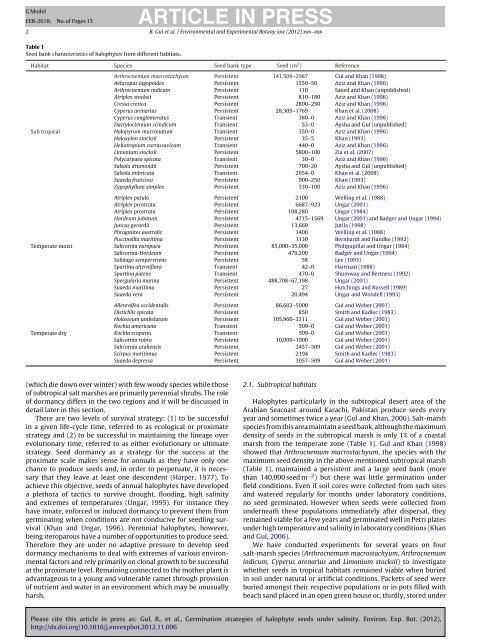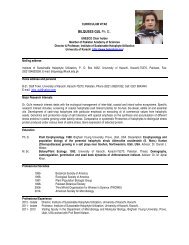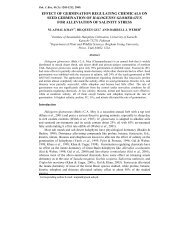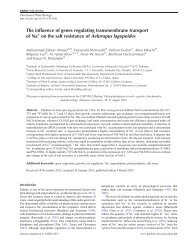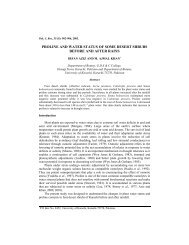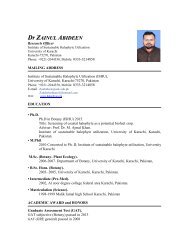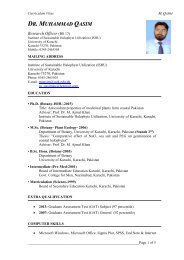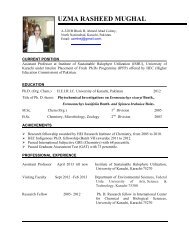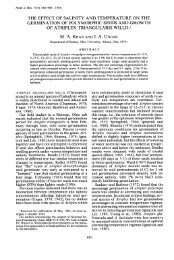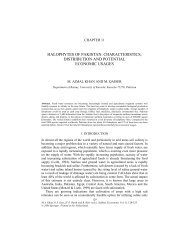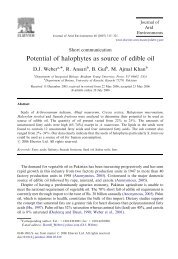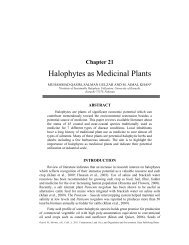Germination strategies of halophyte seeds under ... - ResearchGate
Germination strategies of halophyte seeds under ... - ResearchGate
Germination strategies of halophyte seeds under ... - ResearchGate
You also want an ePaper? Increase the reach of your titles
YUMPU automatically turns print PDFs into web optimized ePapers that Google loves.
ARTICLE IN PRESS<br />
G Model<br />
EEB-2616; No. <strong>of</strong> Pages 15<br />
2 B. Gul et al. / Environmental and Experimental Botany xxx (2012) xxx–xxx<br />
Table 1<br />
Seed bank characteristics <strong>of</strong> <strong>halophyte</strong>s from different habitats.<br />
Habitat Species Seed bank type Seed (m 2 ) Reference<br />
Sub tropical<br />
Temperate moist<br />
Temperate dry<br />
Arthrocnemum macrostachyum Persistent 141,509–2987 Gul and Khan (1998)<br />
Aeluropus lagopoides Persistent 1550–50 Aziz and Khan (1996)<br />
Arthrocnemum indicum Persistent 110 Saeed and Khan (unpublished)<br />
Atriplex stocksii Persistent 810–180 Aziz and Khan (1996)<br />
Cressa cretica Persistent 2800–250 Aziz and Khan (1996)<br />
Cyperus arenarius Persistent 28,309–1769 Khan et al. (2008)<br />
Cyperus conglomeratus Transient 380–0 Aziz and Khan (1996)<br />
Dactyloctenium scindicum Transient 53–0 Aysha and Gul (unpublished)<br />
Halopyrum mucronatum Transient 350–0 Aziz and Khan (1996)<br />
Haloxylon stocksii Persistent 35–5 Khan (1993)<br />
Heliotropium currassavicum Transient 440–0 Aziz and Khan (1996)<br />
Limonium stocksii Persistent 5800–100 Zia et al. (2007)<br />
Polycarpaea spicata Transient 30–0 Aziz and Khan (1996)<br />
Salsola drumondii Persistent 700–20 Aysha and Gul (unpublished)<br />
Salsola imbricata Transient 2654–0 Khan et al. (2008)<br />
Suaeda fruticosa Persistent 900–250 Khan (1993)<br />
Zygophyllum simplex Persistent 330–100 Aziz and Khan (1996)<br />
Atriplex patula Persistent 2100 Welling et al. (1988)<br />
Atriplex prostrata Persistent 6687–923 Ungar (2001)<br />
Atriplex prostrata Persistent 108,280 Ungar (1984)<br />
Hordeum jubatum Persistent 4715–1569 Ungar (2001) and Badger and Ungar (1994)<br />
Juncus gerardii Persistent 13,669 Jutila (1998)<br />
Phragmites australis Persistent 1400 Welling et al. (1988)<br />
Puccinellia maritima Persistent 1130 Bernhardt and Handke (1992)<br />
Salicornia europaea Persistent 85,000–35,000 Philipupillai and Ungar (1984)<br />
Salicornia-Hordeum Persistent 479,200 Badger and Ungar (1994)<br />
Solidago sempervirens Persistent 58 Lee (1993)<br />
Spartina alterniflora Transient 42–0 Hartman (1988)<br />
Spartina patens Transient 470–0 Shumway and Bertness (1992)<br />
Spergularia marina Persistent 488,708–67,198 Ungar (2001)<br />
Suaeda maritima Persistent 27 Hutchings and Russell (1989)<br />
Suaeda vera Persistent 20,494 Ungar and Woodell (1993)<br />
Allenrolfea occidentalis Persistent 86,602–5000 Gul and Weber (2001)<br />
Distichlis spicata Persistent 850 Smith and Kadlec (1983)<br />
Holosteum umbelatum Persistent 105,960–3311 Gul and Weber (2001)<br />
Kochia americana Transient 509–0 Gul and Weber (2001)<br />
Kochia scoparia Transient 509–0 Gul and Weber (2001)<br />
Salicornia rubra Persistent 10,000–1000 Gul and Weber (2001)<br />
Salicornia utahensis Persistent 2457–509 Gul and Weber (2001)<br />
Scirpus maritimus Persistent 2194 Smith and Kadlec (1983)<br />
Suaeda depressa Persistent 3057–509 Gul and Weber (2001)<br />
(which die down over winter) with few woody species while those<br />
<strong>of</strong> subtropical salt marshes are primarily perennial shrubs. The role<br />
<strong>of</strong> dormancy differs in the two regions and it will be discussed in<br />
detail later in this section.<br />
There are two levels <strong>of</strong> survival strategy: (1) to be successful<br />
in a given life-cycle time, referred to as ecological or proximate<br />
strategy and (2) to be successful in maintaining the lineage over<br />
evolutionary time, referred to as either evolutionary or ultimate<br />
strategy. Seed dormancy as a strategy for the success at the<br />
proximate scale makes sense for annuals as they have only one<br />
chance to produce <strong>seeds</strong> and, in order to perpetuate, it is necessary<br />
that they leave at least one descendent (Harper, 1977). To<br />
achieve this objective, <strong>seeds</strong> <strong>of</strong> annual <strong>halophyte</strong>s have developed<br />
a plethora <strong>of</strong> tactics to survive drought, flooding, high salinity<br />
and extremes <strong>of</strong> temperatures (Ungar, 1995). For instance they<br />
have innate, enforced or induced dormancy to prevent them from<br />
germinating when conditions are not conducive for seedling survival<br />
(Khan and Ungar, 1996). Perennial <strong>halophyte</strong>s, however,<br />
being iteroparous have a number <strong>of</strong> opportunities to produce seed.<br />
Therefore they are <strong>under</strong> no adaptive pressure to develop seed<br />
dormancy mechanisms to deal with extremes <strong>of</strong> various environmental<br />
factors and rely primarily on clonal growth to be successful<br />
at the proximate level. Remaining connected to the mother plant is<br />
advantageous to a young and vulnerable ramet through provision<br />
<strong>of</strong> nutrient and water in an environment which may be unusually<br />
harsh.<br />
2.1. Subtropical habitats<br />
Halophytes particularly in the subtropical desert area <strong>of</strong> the<br />
Arabian Seacoast around Karachi, Pakistan produce <strong>seeds</strong> every<br />
year and sometimes twice a year (Gul and Khan, 2006). Salt-marsh<br />
species from this area maintain a seed bank, although the maximum<br />
density <strong>of</strong> <strong>seeds</strong> in the subtropical marsh is only 1% <strong>of</strong> a coastal<br />
marsh from the temperate zone (Table 1). Gul and Khan (1998)<br />
showed that Arthrocnemum macrostachyum, the species with the<br />
maximum seed density in the above mentioned subtropical marsh<br />
(Table 1), maintained a persistent and a large seed bank (more<br />
than 140,000 seed m −2 ) but there was little germination <strong>under</strong><br />
field conditions. Even if soil cores were collected from such sites<br />
and watered regularly for months <strong>under</strong> laboratory conditions,<br />
no seed germinated. However when <strong>seeds</strong> were collected from<br />
<strong>under</strong>neath these populations immediately after dispersal, they<br />
remained viable for a few years and germinated well in Petri plates<br />
<strong>under</strong> high temperature and salinity in laboratory conditions (Khan<br />
and Gul, 2006).<br />
We have conducted experiments for several years on four<br />
salt-marsh species (Arthrocnemum macrostachyum, Arthrocnemum<br />
indicum, Cyperus arenarius and Limonium stocksii) to investigate<br />
whether <strong>seeds</strong> in tropical habitats remained viable when buried<br />
in soil <strong>under</strong> natural or artificial conditions. Packets <strong>of</strong> seed were<br />
buried amongst their respective populations or in pots filled with<br />
beach sand placed in an open green house or, thirdly, stored <strong>under</strong><br />
Please cite this article in press as: Gul, B., et al., <strong>Germination</strong> <strong>strategies</strong> <strong>of</strong> <strong>halophyte</strong> <strong>seeds</strong> <strong>under</strong> salinity. Environ. Exp. Bot. (2012),<br />
http://dx.doi.org/10.1016/j.envexpbot.2012.11.006


